Banner
SUPPORT PORTAL
FAQ
FREQUENTLY ASKED QUESTIONS
The following FAQ are intended to provide you with information concerning the use of Banner batteries in the most efficient and speedy way possible. You can also find additional answers to your questions via the FAQ search and tag-selection.
– In view of the sensitive electronic components in the vehicle, as a rule starting assistance should only be provided by means of a Banner Booster.
– Starting assistance from vehicle to vehicle can lead to voltage peaks during disconnection, which can damage or even destroy vehicle electronic systems.
– Therefore, it is essential that the following procedure be strictly observed when using starter cables!
– Standardised starter cables (e.g. in accordance with DIN 72 553) should always be used for giving starting assistance.
– Observe the instructions for use of the starter cables.
– Only connect batteries with the same nominal voltage.
– When connecting the terminals, both vehicle engines must be switched off!
First connect the two positive terminals 1 with 2. Then connect the negative terminal of the assisting vehicle 3 with 4, the blank metallic point on the vehicle needing assistance, away from the battery. (Observe the instructions of the vehicle manufacturer.)
– Now start the vehicle needing assistance for a maximum of 15 seconds. Do not start the assisting vehicle.
– When disconnecting the terminals, remove the cables in the reverse sequence to the above.
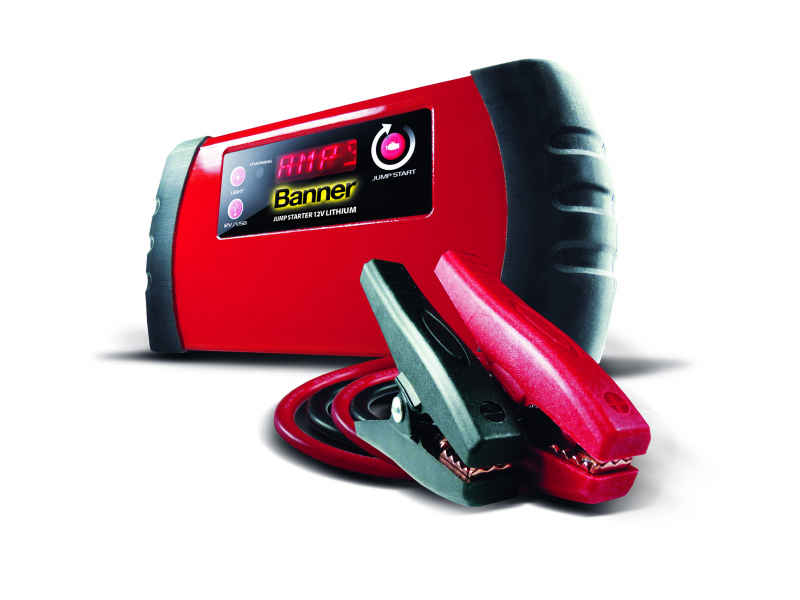
In order to ensure maximum battery life, the following instructions should be followed:
– Keep the surfaces of the battery clean and dry.
– Check the acid levels regularly and if necessary top up with desalinated or distilled water. Never top up with acid. If a substantial water loss occurs, an expert should check the voltage regulator.
– Do not put so-called additives into the battery acid.
– The level of charge of the battery can be checked by means of acid density or open circuit voltage measurement If the density of the acid is below 1.24 or 12,50V kg/l the battery must be recharged .
- In case of saisonal driven vehicles we recommend an external charging twice a year.
In either case the battery must be fully charged before taking out of service.
Running Bull AGM/BackUp: the charge status can only be determined via the off-load voltage. The battery is to be recharged in the case of off-load voltage of ≤12.50V. Acid density measurement, or topping up with distilled water, is not possible - it destroys the battery.
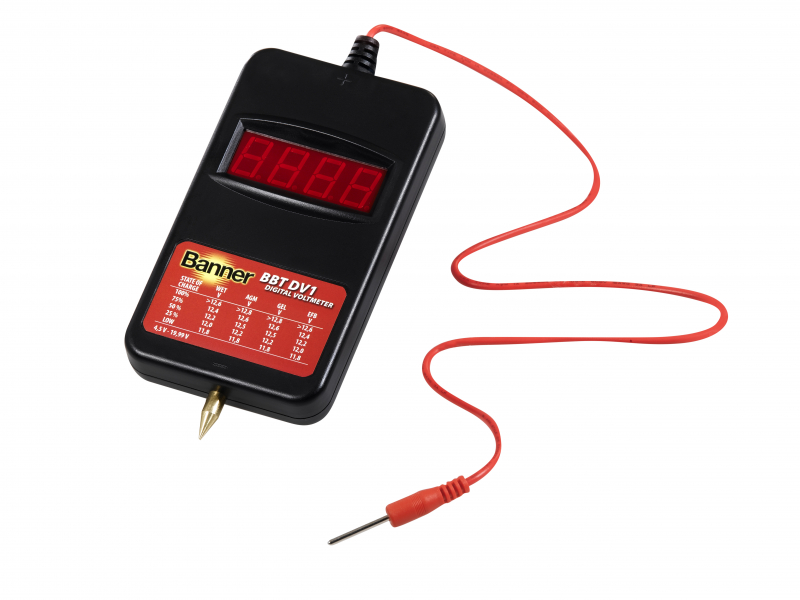
– Before charging a wet battery, check the electrolyte level and top up if necessary with de-ionised or distilled water to the maximum acid level mark, or 15mm above the upper edge of the plates.
Should the battery be removed prior to recharging in order to prevent damage to the vehicle?
Please note the charger type. The operating instructions of the vehicle or the charger manufacturer frequently contain valuable tips regarding battery charging in the vehicle.
In general, a fully automatic charger (charging voltage limitation of 14.8V) is well suited to the charging of a battery installed in a vehicle.
Should your charger have an automatic mode with voltages >15.9V, it is vital that the battery be separated from the in-board electronics and removed from the vehicle.
In a worst case scenario it is possible that the installed control devices can be destroyed due to overvoltage and the resulting damage would be enormous. Warning! Follow the vehicle manufacturer’s instructions when disconnecting the terminals.
– Batteries may only be charged with direct current. Connect the positive (+) battery terminal to the positive (+) terminal of the charger, and the negative (-) battery terminal to the negative (-) terminal of the charger.
– Do not switch on the charger until the battery has been disconnected. When charging is completed, switch off the charger before disconnecting the battery.
– It is recommended that the charging current be equal to one tenth of the capacity (e.g. 44Ah divided by 10 = 4.4A charging current).
– The temperature of the acid may not exceed 55°C during charging. If the temperature rises above 55°C, the charging process must be discontinued.
– The fittings must not be opened.
- Ensure that recharging amounts to 1.2 times the consumed capacity (e.g. consumed capacity 30Ah, recharge 36Ah)
– Charging must be performed in a well-ventilated room.
– Charging is finished when the current drops to 0 or stops falling, or if the automatic charger switches off.
For deep discharged flooded batteries we recommend a charging voltage of 16V (separate the battery from the onboard electronics)!
Warning! Oxyhydrogen gas is formed during charging! It is essential that fires, sparks, open flames and smoking be prevented!
Running Bull AGM/BackUp: only recharge with a voltage controlled charger (max. 14.8V)! The use of standard, non-voltage controlled chargers will destroy the battery through overloading and cause the electrolyte to escape!
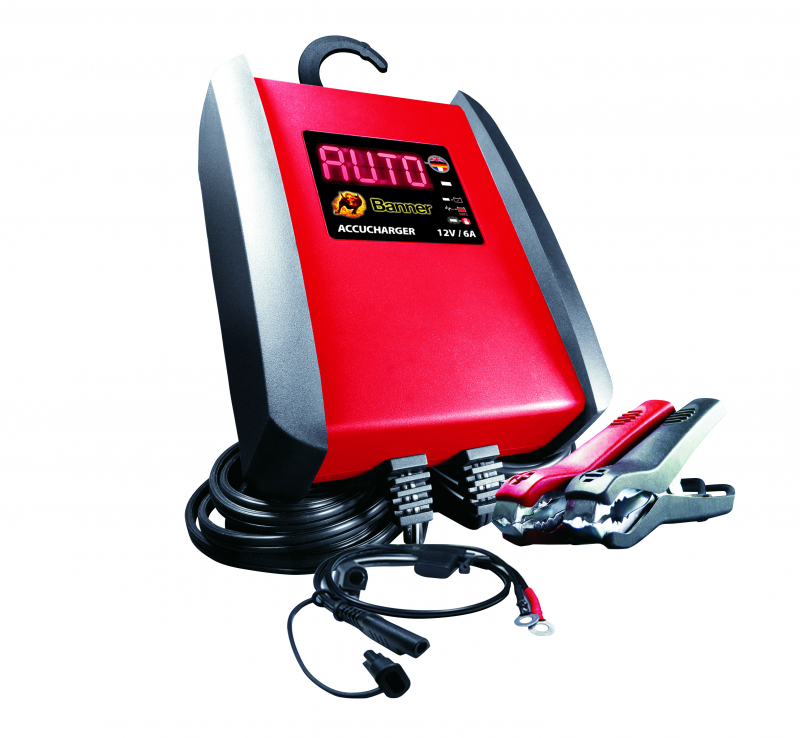
Should the bike not be used or be garaged for a lengthy period (standstills or winter mothballing), remove the battery and store it in a dry and cool place (frost-free). It is essential that the battery be fully charged and gets recharged when reaching 12.50V or connect it to a charge retention device (e.g. Banner Accucharger).
Ideally, you should use a voltage-regulated charger (Banner Accucharger). These devices carry out charging automatically and depending on the battery capacity, you can employ the following chargers:
3-20 Ah - Banner Accucharger 6/12V 2A - Art.No. 1240000020
> 20 Ah - Banner Accucharger 12V 3A - Art.No. 1240000030
- Remove the battery from the vehicle and under all circumstances unclamp the battery cables (minus terminal first). Warning! Without a power supply, in-board computer and radio data, etc. can be lost!
- First connect the charger to the battery and then switch on. Following charging, first switch off the charger and then disconnect it from the battery.
- Charging current: max. 1/10 Amp of the battery capacity.
- Stop charging at an acid temperature of more +55°C.
- After charging, check the electrolyte level and if necessary top up with distilled or de-ionised water (only applies to wet batteries, not to AGM, GEL or AGM PROfessional batteries!).
- Ensure good ventilation when charging. Highly explosive oxyhydrogen gas forms during charging. Therefore, it is vital that smoking, open flames and sparks be prevented.
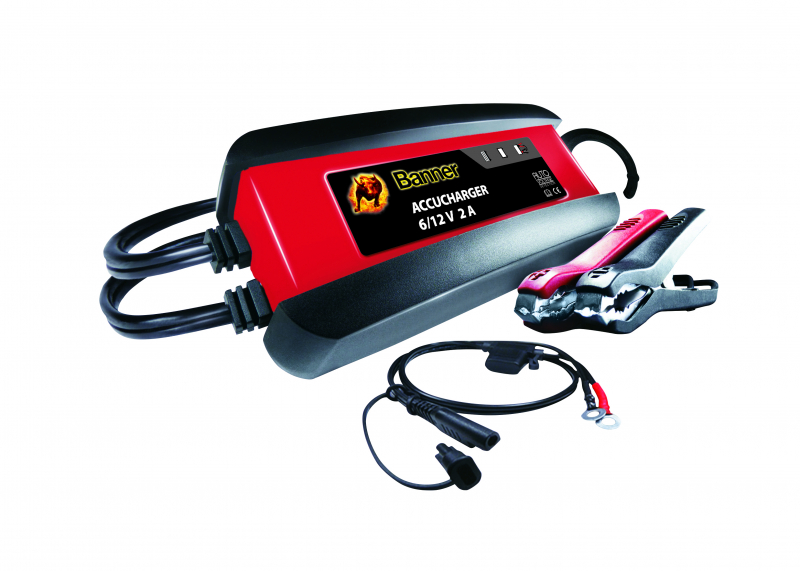
In order to achieve full performance and service life, the battery must be fully charged prior to installation (1. + 2.).
1. Bike Bull
Preparation. The degassing vent is closed and must be opened before putting into operation. Remove the protective cap, or cut off the degassing hose at the end.
Filling. Remove all battery stoppers. Only use special acid (density 1.28 kg/l), which is supplied with the battery in a special plastic container. Fill to the maximum mark and then allow the battery to rest for 30 minutes.
Warning! The acid container with any residual acid should be brought to a hazardous waste collection point. Acid residues may not enter the sewerage system. Empty acid containers should be disposed of as domestic plastic waste.
Commissioning. In order to reach full performance, once the battery has been filled with acid it must be fully charged prior to installation. In accordance with the instructions for use of the charger and the battery, charging can take place for approx. 5-10 hours at a maximum of one-tenth of battery capacity (Ah).
Battery capacity can be ascertained by means of the DIN number on the individual box. Numbers 2 and 3, e.g. 509 14 have 9 Ah capacity and therefore require charging current of approx. 0.9 A. After charging, the acid level should be checked and if necessary topped up with demineralised water. The battery can then be closed with the stoppers.
Maintenance. Never allow the acid to fall below the minimum level. Only use demineralised water (desalinated or distilled water according to VDE 0510).
Please note! The Bike Bull cannot be installed in a lateral position!
2. Bike Bull AGM
Preparation. Remove the battery seal shortly before filling. A slight hissing sound can be heard.
Filling. Only use special acid (density 1.32 kg/l), which is supplied with the battery in a special plastic container. Then allow the battery to rest for 30 minutes. After filling, the battery is closed with the stopper strip and may not be reopened, as this would destroy the battery! Warning! The acid container with any residual acid should be brought to a hazardous waste collection point. Acid residues may not enter the sewerage system. Empty acid containers should be disposed of as domestic plastic waste.
Commissioning. In order to reach full performance, once the battery has been filled with acid it must be fully charged prior to installation. In accordance with the instructions for use of the charger and the battery, charging can take place for approx. 5-10 hours at a maximum of one-tenth of battery capacity (Ah). Battery capacity can be ascertained by means of the DIN number on the individual box. Numbers 2 and 3, e.g. 518 21 have 18 Ah capacity and therefore require charging current of approx. 1.8 A.
Please note! The Bike Bull AGM cannot be installed in a lateral position!
3. Bike Bull GEL, AGM PROfessional
Putting into operation. The battery is fully charged and ready for install.
Please note: The Bike Bull GEL / Bike Bull AGM PROfessional can be installed in a lateral position!
Use of a voltage controlled Banner Accucharger 6/12V 2A or 12V 3A is recommended.
Warning! Never install a maintenance-free battery (AGM, GEL, AGM PROfessional) in a motorcycle without a regulator, as the maximum voltage may not exceed 14.8 V.

Yes, essential.
A conventional starter battery is, as the name suggests, basically designed to provide a high short energy boost to start the vehicle.
As soon as the engine is running, the vehicle's charging system ensures that the energy taken from the battery is recharged and supplies all other electrical loads.
A start/stop battery is responsible for much more than just starting the engine.
Namely to supply the various electrical consumers with energy when the vehicle is stationary, the engine is not running (stops) and the complete on-board power supply including the next starting process must still be ensured!
This means that the technology and components of a start/stop battery differ significantly from those of a conventional starter battery.
Please note:
If a conventional wet battery is installed in a vehicle with start/stop technology, by mistake - due to an allocation error - or due to incorrect cost awareness, a battery breakdown or total failure is pre-programmed. Depending on the driving profile (short distance, stop-and-go,...) a conventional starter battery will be defective within a few months due to the extremely high cyclic load due to the engine start-stop function.
The battery breakdown also leads to the failure of various vehicle functions (including start-stop). Not to mention the customer's annoyance about the battery failure, possible loss of time, waiting for help, delays, scheduling problems and dissatisfaction with the installed spare battery.
Do not install a conventional wet battery in a vehicle with a start/stop function that is equipped with an AGM* or EFB** battery as standard. If necessary, an AGM or EFB battery must be used again! In identical housing and identical performance class.
These tips must be followed when changing the battery!
Banner Tip: The EFB battery can be upgraded to the even more powerful and more cyclical Running Bull AGM battery in H5/L2 (60Ah), H6/L3 (70Ah) and H7/L4 (80Ah) housings. Please contact your Banner Account Manager.
AGM = Absorbent Glass Mat, the acid is absorbed in the glass fleece and thus bound
EFF = Enhanced Flooded Battery, the cycle-proof starter battery
You can calculate the correct capacity for your Energy Bull as shown in the following example:
You need a battery for an electrically powered boat. A 600W e-motor is used with a 24V electrical system. In addition, a radio, various navigation lights and a depth sounder have to be supplied with power (total 50W). Five hours of autonomous operation are required.
These values are now used in the following equation:
Wattage: Volt = Ampere x Hours x Safety Factor = Battery Capacity in Ah i.e. 650 : 24 = 27 x 5 x 1.7 = 230Ah (k20)
A safety factor of 70% should be used for wet batteries (30% for AGM and gel recombination batteries). In the case above, two Energy Bull 968 01 batteries (230Ah each) used in sequence would be advisable.
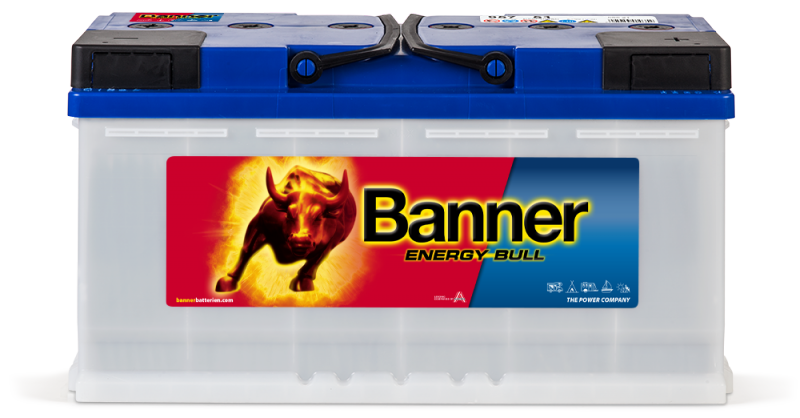
The automatic start/stop automatically switches the engine off and on again when you walk off or step on the clutch or brake during a stop.
The savings potential:
Depending on the driving situation, especially in city traffic,
up to 0.8 l less fuel per 100 km!
The basic requirement:
An especially strong and cycle-proof start/stop battery that remains fully efficient even during frequent charging and discharging processes.
Banner start/stop car batteries are real CO2 and fuel savers.
With the highly specialized batteries of the Running Bull series, Banner completely covers the segment of power supply for start-stop vehicles. The particularly high cycle stability makes Running Bull the ideal on-board power plant that safely masters the extreme loads caused by the multiple starting processes of micro-hybrid vehicles.
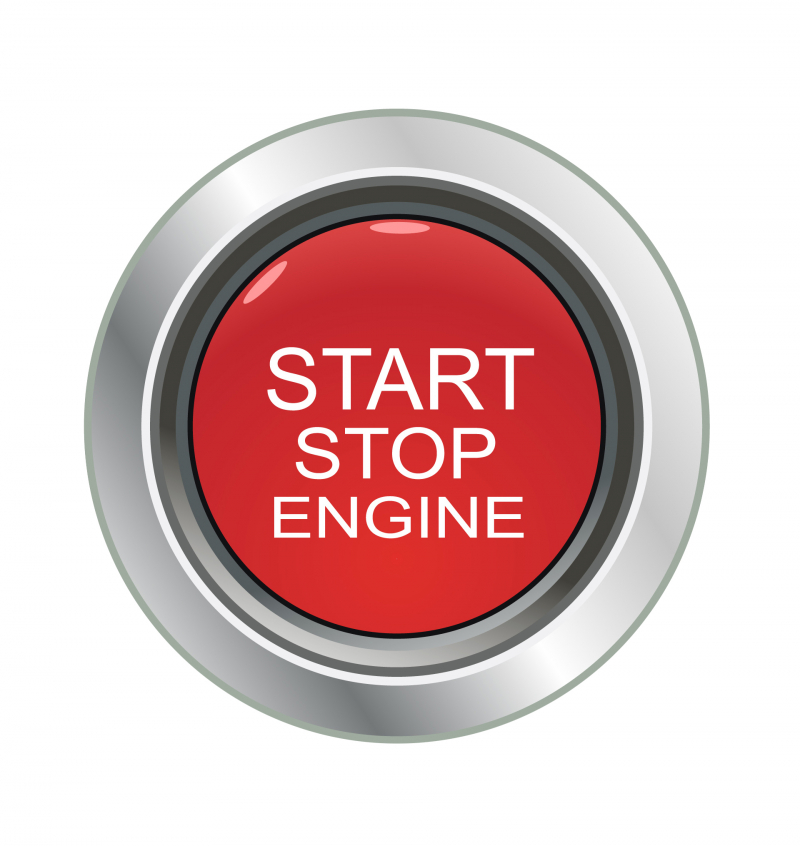
Finding the right battery for use in a motor caravan is not that simple. The text below is intended to provide some explanations regarding the Energy Bull and shed some light on alternative possibilities.
Charging:
Pay close attention to the appropriate dimensions of the feed cable (in order to minimise voltage loss).
The charging voltage for Energy Bull batteries should amount to 14.2 – 14.4V. In order to achieve suitable battery life, the charging current should not amount to more than five times the rated current* (see subsequent calculation).
All in all, the Energy Bull is a good cyclical battery, which forgives a great deal (as opposed to gel or AGM batteries). The “disadvantage” of Energy Bull batteries as compared to AGM or gel batteries relates to maintenance. For when an Energy Bull battery is employed, it is imperative that the electrolyte level is checked regularly. During intensive use (camping operation) this should take place on a monthly basis, otherwise quarterly and half-yearly inspections are sufficient.
Gel and AGM batteries are maintenance-free.
A reasonable price, insensitivity to high temperatures and higher charging voltages are all positive factors in favour of the Energy Bull.
Solar cells
In the case of solar cells make certain that you have a “good“ regulator. Ideally, this should have pulse-width modulation (PWM), temperature compensation and freely selectable parameters (charging voltage...).
Discharging
Inverters require a sizeable amount of discharge current from the battery.
In principle, Energy Bull and gel batteries are unsuitable for high current discharges (>40 times the rated current* for >1min).
Should you require increased amounts of discharge current, we recommend the use of an AGM battery (Running Bull).
*--> Calculation of the rated current follows!
Capacity
It is preferable that the batteries are only operated with low discharge depths.
A lead-acid battery can withstand a certain degree of capacity conversion (= number of conversions of the rated capacity).
The flatter the cycle, the higher the number of possible repeats.
As far as cyclical capability is concerned, if handled with care the gel battery offers roughly twice the service life of an Energy Bull.
Degassing
Should the battery be installed inside the vehicle, it must be fitted with a degassing hose with an external outlet. When selecting a battery please choose a type that has a central degassing connection.
--> This allows the gases created during charging (hydrogen and oxygen) to be conducted out of the vehicle.
In a normal operational condition, AGM and gel batteries do not generate any gas (exception: a charger or battery defect). However, for safety reasons a degassing hose must be employed.
Energy Bull batteries generate gases during standard operation and therefore it is essential that a degassing hose is used.
*Rated current calculation
Example: 100Ah (K20) Energy Bull 95751
Rated current (In) = 100 Ah: 20 h = 5A
Maximum charging current = 5 x In = 25A
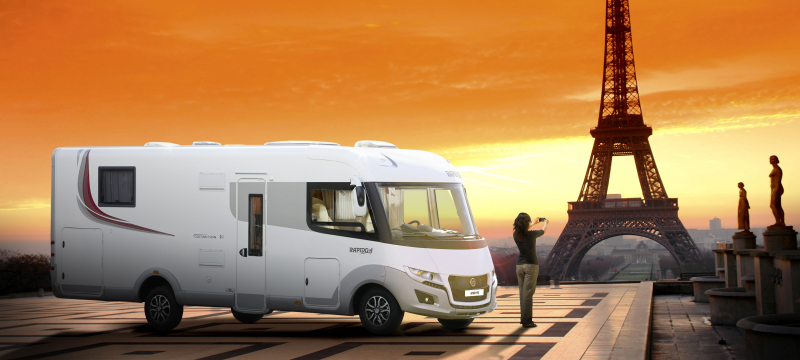
As a result of our experience, we know that sufficient charging of the battery when driving is unfortunately only possible to a very limited extent. Particularly in summer (air conditioning running at high power, lights on, radio playing, refrigerator running,...) there is very little residual current for the complete recharging of a battery. In some cases, the living area battery must even support the on-board supply ...
The use of a B2B charger represents a sensible approach. At the very least, these devices serve to raise the charged voltage to a reasonable level.
If, for example, your batteries are approximately 50% discharged (95A are missing) some 105 Ah have to be recharged in order to bring the battery up to full power.
At best, 15A (on average) remain for the living area battery and this means that you would have to drive your vehicle for at least 7h in order to achieve full charging!
In order to obtain the maximum service life from your battery, please ensure complete separation from the on-board supply when the vehicle is not in use (>7 days).
--> Appropriate full charging of the battery should take place beforehand.

Quite simply, brake energy recovery.
When you accelerate or brake, some of your car's kinetic energy is usually lost. Part of this energy is recovered through recuperation.
This is because the alternator (also called generator) intentionally puts more strain on it in this phase, the voltage of the alternator is raised so that the charging process is accelerated and thus more energy is supplied to the battery. The alternator converts the kinetic energy into electricity, in principle like a bicycle dynamo. In acceleration phases and in normal operation, the output of the alternator can be partially reduced or even set to zero, which means more energy is available for the drive.
The reason: The vehicle now uses the energy that the battery has previously stored. This saves fuel and emissions. Because Banner Running Bull series start-stop car batteries are real CO2 and fuel savers.
Energy for the environment.
Brake energy recovery and start/stop systems make modern cars much more environmentally friendly. With sustainable fuel savings and CO2 emission reductions.
Basic requirement: An extremely cycle-resistant start/stop battery Banner Running Bull, which reliably delivers maximum performance at start for start and drive for drive.
The particularly high cycle stability makes Running Bull the ideal on-board power plant that safely masters the extreme loads caused by the multiple starting processes of micro-hybrid vehicles.
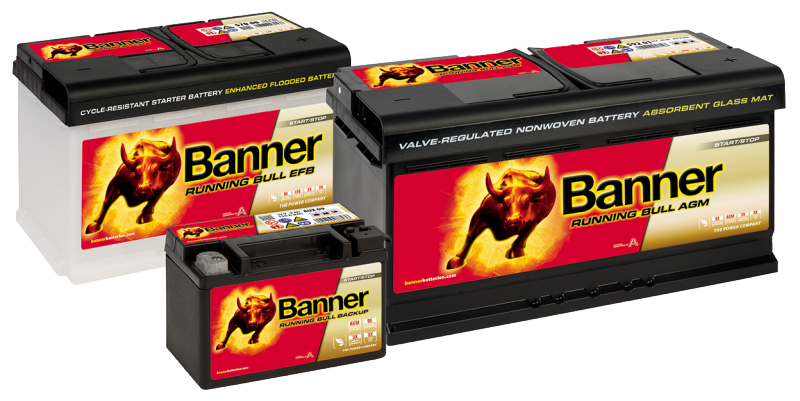
Yes, in the case of many battery types.
If in your case, the side of the degassing opening is unsuitable, the white plug can be removed, but must then be reinserted on the other side in the degasification duct (in order to prevent the escape of oxyhydrogen gas).
In order to remove the plug, please use a wood screw with a diameter of approx. 5 mm. There is no need for concern, as the plug cannot be pushed into the battery.
P.S. The Starting Bull Europa types (total heights 175 or 190 mm) have an opening for the central degassing connection on the right-hand side (+terminal side in batteries with connection 0, -terminal side with connection 1). Please note that no change of degassing side is possible.
The current installation situation in brief:
For all the batteries in the latest BMW and Mercedes-Benz vehicles, degassing is on the + terminal side and therefore on the right in the case of batteries with connection 0.
In currently manufactured VW Group vehicles all batteries are degassed on the - terminal side and therefore on the left in the case of batteries with connection 0.
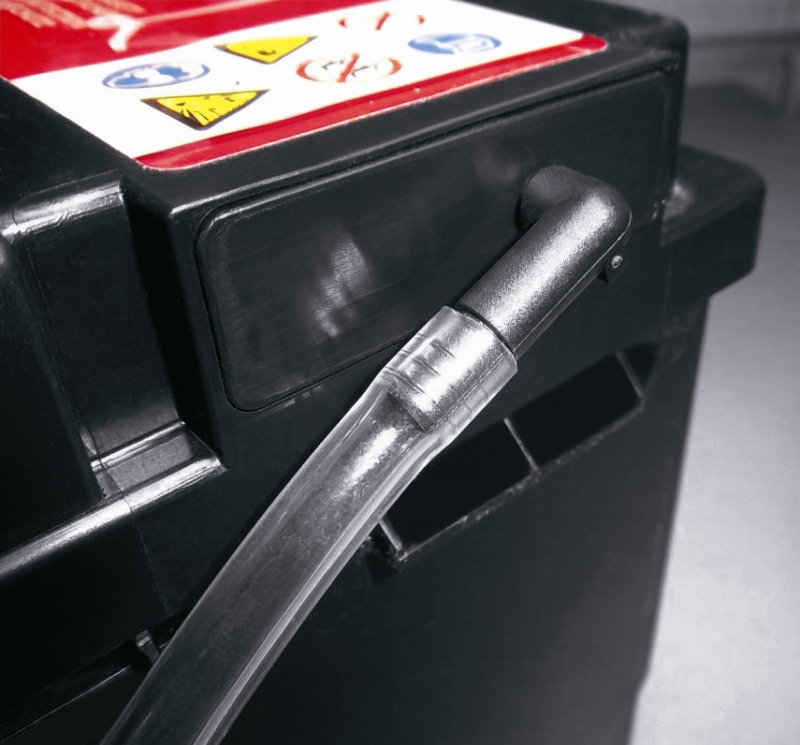
Some vehicles are equipped with a degassing hose with an angled elbow to drain off the battery gases. If this applies to a vehicle, the hose must be inserted into the appropriate vent opening of the battery via the elbow. If a degassing opening is present on the other side, it must be closed with a closing plug!
In case of replacement of closing plugs/stoppers for battery degassing or degassing hose, please contact your Banner sales partner/sales consultant.
For your own safety, please constantly employ protective eyewear when handling lead-acid batteries.
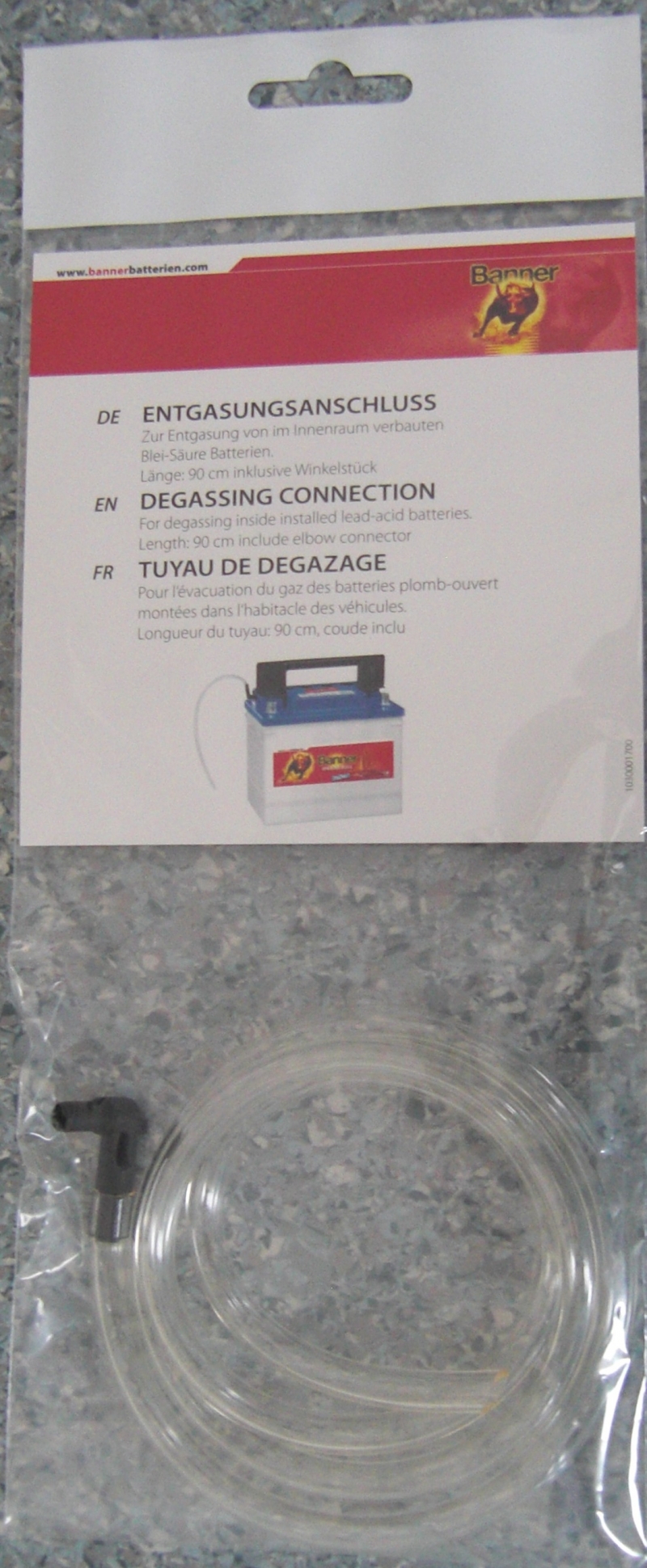
For vehicles with automatic start/stop, two different battery technologies are used, depending on energy requirements and the required vibration and cycle resistance.
The technology used also depends largely on the electrical equipment of the vehicle and the price structure.
1. AGM technology (Running Bull AGM) is mainly used in start/stop systems with maximum energy consumption and brake energy recovery.
The Running Bull AGM battery is the ideal solution here, primarily for medium and luxury vehicles.
AGM = Absorbent Glass Mat, the acid is absorbed in the glass fleece and thus bound.
2) EFB technology (Running Bull EFB) is mainly used in start/stop systems with high energy consumption.
The Running Bull EFB battery is the ideal solution for small cars up to the upper middle class.
EFB = Enhanced Flooded Battery, the cycle-proof starter battery.
Always observe when changing the battery:
Never install a conventional wet battery in a vehicle with start/stop function that is equipped with an AGM or EFB battery as standard. If necessary, an AGM or EFB battery must be used again! In identical housing and identical performance class.
Banner Tip: The EFB battery can be upgraded to the even more powerful and more cyclical Running Bull AGM battery in H5/L2 (60Ah), H6/L3 (70Ah) and H7/L4 (80Ah) housings.
The degassing elbow including the hose (part number: 10300017000) is available at every Banner sales partner.
The Retailer finder shows the nearest Banner sales partner.
Insert the degassing hose by using the elbow at the central degassing opening at the side of the battery cover.
No additional work is necessary.
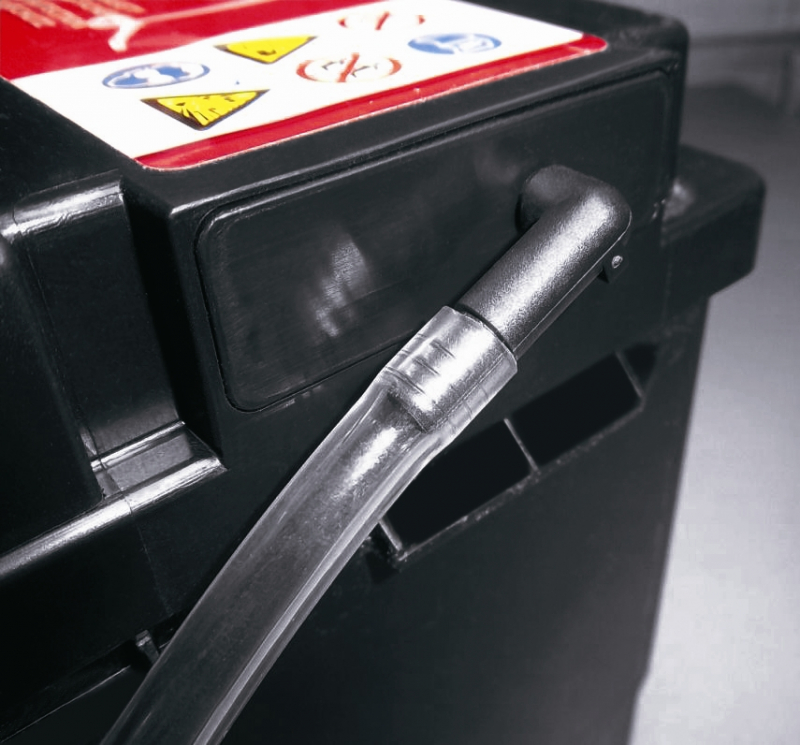
In principle, the AGM battery is not foreseen for use on its side. However, owing to the battery’s design it is nonetheless possible to employ it in this position. See image Menzi Muck walking excavator. In spite of this fact, a degassing hose should be fitted (for safety reasons). In an unfortunate situation (damage to the charger or the battery), acid can escape more easily when the battery is in a lateral position.
Moreover, depending upon the application (starter battery,...) this installation position may lead to slight limitations on service life.
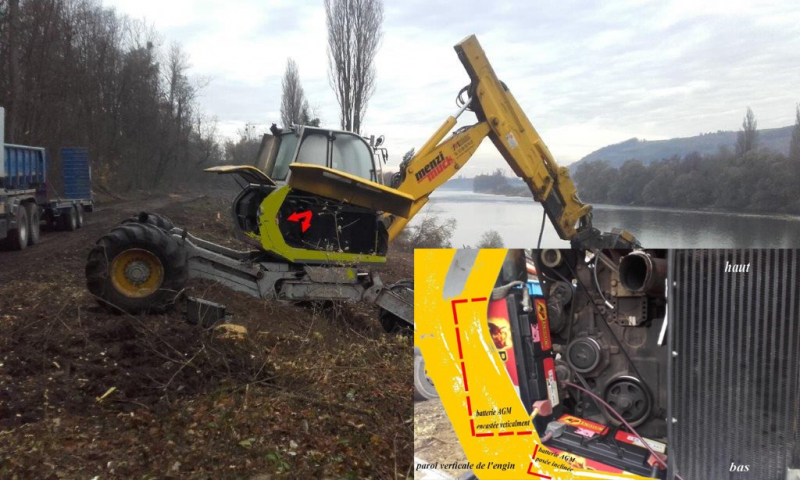
During series connection the voltages of the individual batteries accumulate. In order to create a 24 V electrical supply system, two batteries must be connected in series.
Please note:
- Both batteries must have the same type designation.
- Both batteries must be of roughly the same age.
- Both batteries must have the same charge status.
- The connecting lines must have sufficient dimensions and be as short as possible.
- Always exchange both batteries!
Should the aforementioned recommendations not be followed, differing internal resistance of the individual batteries causes a corresponding voltage distribution and thus an asymmetrical load during the loading and discharge phase.
The charging equalizer provides two batteries connected in series with a uniform charge status.
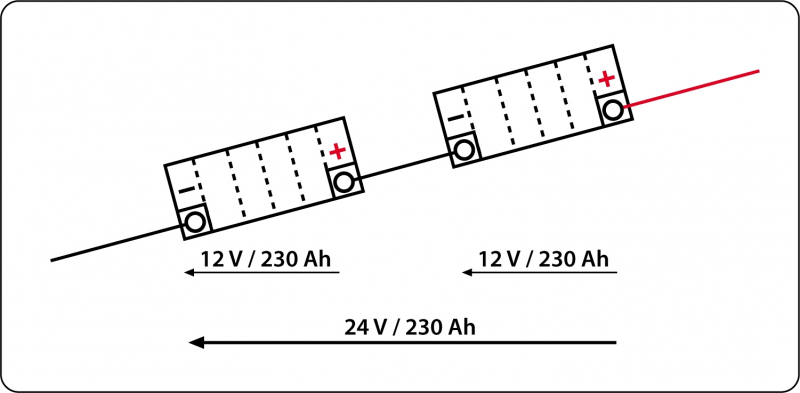
In a parallel connection, the individual capacities and the cold start current of the individual batteries are accumulated.
Please note:
- Both batteries must have the same type designation.
- Both batteries must be of roughly the same age.
- Both batteries must have the same charge status.
- The connecting lines must have sufficient dimensions and be as short as possible.
- Always exchange both batteries!
Should the aforementioned recommendations not be followed, differing internal resistance of the individual batteries causes a corresponding voltage distribution and thus an asymmetrical load during the loading and discharge phase. As a result, partly high equalizing current flows between the batteries.
Where installation allows, the use of only one battery with a larger capacity is to be recommended.
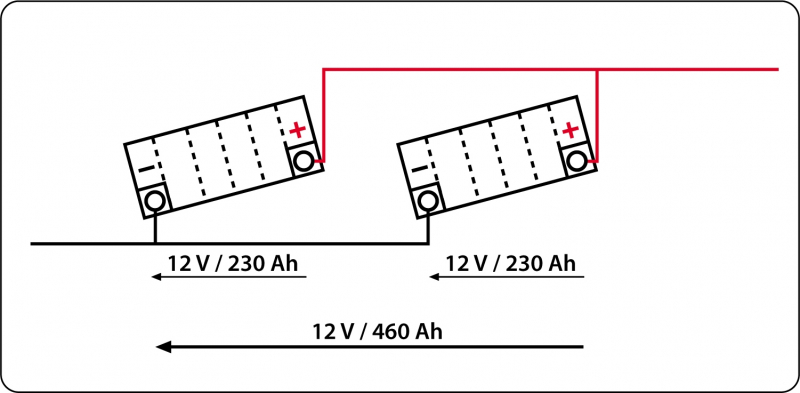
Banner recommends only fit batterie with an open circuit voltage > 12,50V inside a vehicle.
– Before fitting or removing the battery, switch off the engine and all power users.
– Avoid short circuits due to tools.
– When removing the battery, first disconnect the negative (-) terminal and then the positive (+) terminal.
– Prior to fitting the battery, clean the battery compartment.
– Ensure that the battery is secured tightly.
– Clean terminals and battery clips and lubricate lightly with acid-free grease.
– When fitting the battery, first connect the positive (+) terminal and then the negative (-) terminal. Ensure that the clips are secured.
Warning! Always follow the instructions (operating or maintenance) of the vehicle manufacturer!
– Empty batteries do not need maintenance. Store in a dry and cool environment (frost-free).
– Recharge filled starter batteries when acid density is below 1.24 kg/l (off-load voltage < 12.50V).
– Filled batteries must be transported and stored in an upright position to avoid acid spillage.
– During transportation secure the battery in order to prevent it from falling over.
- Use a short circuit protection
Running Bull AGM/BackUp: leak-proof even when upside down and in the case of damage to the casing. At the latest, recharge in the case of off-load voltage ≤ 12.50V. Acid density measurement and topping up with distilled water are not possible.
It is often the case that in the vehicle discharges exceed charging levels, which leads to a “negative charging balance” that makes life extremely difficult for any battery.
In addition, particularly in winter, numerous consumers burden the vehicle's electrical system and the starter battery. The low temperatures also play a role, as they not only have an effect upon the engine oil, which becomes viscous and causes increased friction forces in the engine, but also impact the chemical reactions and charging capacity of modern Ca/Ca batteries.
A further negative influence derives from the fact that lead-acid batteries can only absorb a charge when they have a temperature of >0°C. Therefore, at the start of a drive all the available charging energy is used to heat the battery (electro-chemical process). Unfortunately, once the battery has reached the charging range, the drive is frequently over and the majority of car owners switch off the engine.
It should be noted that depending on the vehicle type and the location of the battery, the temperature range needed for charge intake is only attained after a journey of at least 20 km. However, this problem can be eased through recharging with an external charger.

The discharging is most likely caused by a high closed current (>20mA) of the vehicle.
Recharge the battery with an external charging device (constant voltage with max. 14.8V) completely full and measure the open circuit voltage after a rest time of min. 5 hours.
The measured voltage should be approx. 12.7-12.8.
If the voltage is higher please turn on the lights for 10 seconds and repeat the measurement again after 1 minute.
If the voltage is under 12.6V you have to charge the battery again.
If your charging device has a kind of "reconditioning mode" disconnect the battery from the on board electronics to avoid irreversible damages.
The electrolyte level must be checked in line with frequency of use and charge voltage.
- In the case of daily charging or discharge, the intervals between electrolyte checks should amount to one month.
- In the case of weekly charging or discharge, maintenance should take place on a quarterly basis.
Before handling the battery, it is essential that you put on your personal protection equipment (safety eyewear, ...). Only use de-ionised or distilled water for topping up the electrolyte (no mineral or spring water).
- Open the cell plugs with an appropriate tool.
- Top up the cell as far as the maximum marking (see the marking on the outside of the casing or the cell clip).
- Close the cell plugs.
- Fully charge the battery in order to thoroughly mix the electrolyte (the battery should gas).
Plate parts that are not covered with acid will be damaged irreversibly!
What happens when a battery without a BEM (Battery Energy Management) code is installed in a vehicle? Banner has had to consider this question in the case of Audi.
BEM = Battery Energy Management. In view of the increasing use of electrical power in modern vehicles, the battery constitutes a vital component. Therefore, in order to guarantee its long service life in spite of higher loads, vehicles such as the Audi A6 employ intelligent energy management.
Function. The massive rise in on-board power requirements in the latest car generation places fresh demands on
batteries, especially in connection with micro-hybrid applications involving stop-start technology and brake energy recuperation. The BEM incorporates ongoing parameters such as the charging status and the age of the battery. This data is then reported to the vehicle computer, which decides upon the energy balance in the vehicle and if required, limits the use of comfort consumers such as seat heating or air conditioning and provides the driver with a warning.
Where possible, the aim is to constantly guarantee engine starts.
Differing systems. The majority of automotive manufacturers such as BMW operate with an open system, i.e. the
independent retrofitting market can install a suitable battery without the need to reprogram the vehicle electronics. However, producers like Audi employ a closed system and allocate so-called BEM codes for original retrofitting batteries. Unfortunately, such codes are unavailable for free spare part batteries.
Installation of batteries without a BEM code. Basically, the installation of a non-BEM free tested battery is possible as exemplified by Audi. However, a battery must be employed that possesses OEM quality (preferably Power Bull PROfessional and in the case of an original AGM battery, replacement with a Running Bull AGM), is of identical dimensions with the original battery and also has the same labelled performance as the original.
Self-teaching system. In the case of an elderly battery, the vehicle system stores the term “defect battery”. Accordingly, if a new battery is installed without the entry of a BEM code, initially the vehicle does not recognise the
presence of a replacement. Therefore, the energy management system must either be informed of the new battery status via a BEM code input, or learn the new battery status. The more trigger events (impulses, signals, e.g. starts, cold starts) experienced by the battery, the faster this process is completed. The vehicle computer then successively releases the previously limited systems, e.g. the full performance of the air conditioning system.
No safety risk. If a high-quality battery is installed without the input of a BEM code, this neither constitutes a safety risk, nor a possible danger of damage to the vehicle electronics or other components.
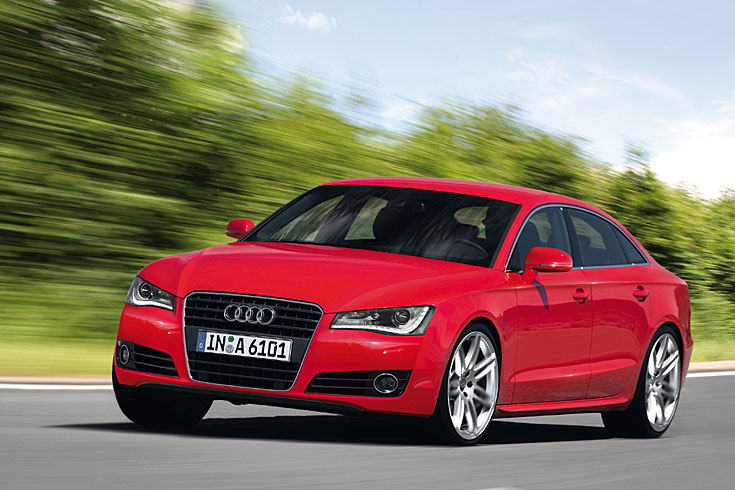
Enclosed, please find the instructions of the safe handling of lead-acid accumulatores, valid for all Banner starter batteries.
The REACH-regulation (1907/2006/EC) has replaced the directive on safety data sheets (91/155/EC). REACH describes the setting up and updating of safety data sheets for substances and preparations. For articles - like lead-acid batteries - safety data sheets are not required.
This leaflet addresses manufacturers of batteries and is meant to apply voluntarily. The notes are meant to help to comply with legal requirements but do not replace them
http://www.bannerbatterien.com/banner/files/Sicherheitsdatenblatt_ZVEI_GB11.2014.pdf
The production date of a Banner battery is contained in the battery's branded product code.
However, the physical age of the battery is very limited as to the battery's life and health. For this reason, the codes stamped on Banner batteries do not allow any self-explanatory conclusions to be drawn about the production date.
The decisive factor for the function of the battery is not the date of the first filling with acid, but the time of commissioning in the vehicle/application.
It is important that the battery is kept in a good state of charge during the period between production and sale of the battery to the user. This is the case with Banner batteries and Banner dealers.
Battery life is then mainly determined by the number of discharge charging cycles and depth of discharge, rather than the physical age of the battery.
Therefore, the only documentation for a warranty and guarantee is the dated battery purchase receipt.
P.S. A DOT marking with a sequence of numbers, as in the case of tyres, etc., which evidences the production date (DOT= Department Of Transportation, USA) is unnecessary in the case of batteries.
Battery acid is extremely caustic!
- In the case of contact with the eyes rinse them out thoroughly with water and consult a physician.
- Acid splashes. Treat with a neutralon spray or suds, rinse with plenty of water and wipe dry.
- Acid or batteries with an acid filling should not get into the hands of children.
- Batteries containing residual acid should be brought to a hazardous waste collection centre.
Acid residues may not enter the sewerage system. Empty acid containers should be disposed of as domestic plastic waste.

At a maximum, an AGM battery may be discharged to a level 50% state of charge.
Basically, it can be said that the deeper the discharge, the shorter the battery life expectancy. With a discharge depth of 50% (approx. 12.3V off-load voltage) an AGM battery manages roughly 400 cycles.
Please make sure that a dormant voltage limit of approx. 12.50V has been reached.
In order to be able to measure off-load voltage, a period of around five hours should elapse following charging, or no discharge should have taken place for at least an hour.

Please always exchange all the linked batteries. This is essential because with cumulative use, batteries demonstrate a change in their internal resistance (increase). Accordingly, a new, fully charged battery has very low internal resistance, while an “old” battery has a very high one.
Should an “old” and a “new” battery be connected, the flows (with parallel connection) and voltages (with sequential connection) spread in a different manner, which creates asymmetric loading during charging and discharging.
If the batteries are not discharged or charged, parallel connection results in flows of very high compensation current between the batteries. --> The “new” battery attempts to recharge the “old” one (potential compensation).
This compensation current can result in an early failure of the “new” battery.
Please employ the AGM setting, which means that the charge voltage should be set at max. 14.8V and the float charge voltage at 13.5V. Best of all, use an IUoU characteristic with temperature compensation (should you have this setting available).
In order to obtain the maximum service life from your battery, please ensure complete separation from the on-board supply when the vehicle is not in use (>7 days). --> Appropriate full charging of the battery should take place beforehand.
Please note the following:
- Both batteries must have roughly the same age!
- Both batteries should have the same off-load voltage.
- Both batteries must bear an identical type designation!
- The connecting cables should be as short as possible.
- Care should be taken that the connecting cables have sufficient dimensions.
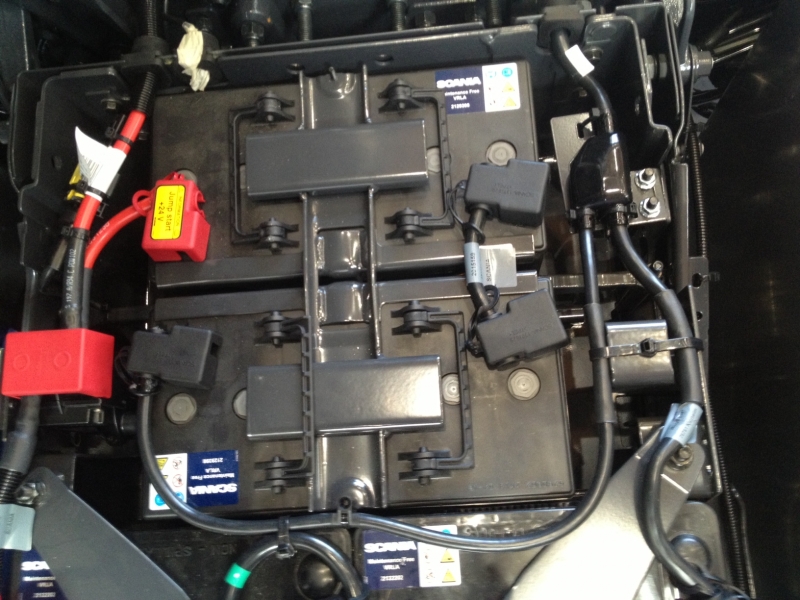
Under circumstances detonating gas is formed when charging a battery. Detonating gas is a high explosive mixture of hydrogen and oxygen. Due to the low explosive limit of 4 vol.% extreme caution is necessary. When exposed to an ignition source (open flame, hot surface, electrostatic discharge,...) the gas causes an explosion-like reaction with a detonation speed amounts to approx. 2,800 m/s (black powder 400-1000 m/s).
Please note:
- Avoid ignition, do not smoke or use open flames and prevent sparking during the handling of cables and electrical appliances.
- All electrical devices with switches should be turned off prior to battery installation or removal, in order to prevent accidental sparking.
- When releasing the connections, first detach the mass cable (link with the vehicle frame). During connection this is the last cable to be attached (avoid short circuits due to tools).
- During charging, first attach the battery to the charger and then switch on the charger.
- Ensure good ventilation during charging in closed rooms.
- Use a degassing hose when the battery is installed inside the vehicle.
- Always use protective eyewear when handling lead-acid batteries.

Only a few types of batteries are dry charged.
All the other batteries are ready for use (filled and charged)!
Dry-charged, starter batteries are ready for use as soon as they have been filled with acid.
– During filling, the temperature of the battery and acid should amount to at least 10°C.
– Remove the vent plugs.
– At a maximum, fill the individual battery cells with sulphuric acid pursuant to VDE 0510 with a density of 1.28 kg/l (1.23 kg/l for tropical countries) up to the acid level mark, or 15 mm above the top of the plates.
– Leave the battery to stand for 20 minutes for the level to settle, gently tip it several times and then top up where necessary.
– Screw or press in the vent plugs tightly, wipe off any surplus acid splashes.
- Before mounting the open circuit voltage must be min. 12.60V or an acid density of 1.26kg/l
Activation charge: If the battery becomes warm at filling, if the electrolyte froths up (intense formation of gas) or if the battery does not reach the values mentioned above after the filling and charging time, an activation charge has to be effected.
One should not combine different kind of batteries as they are of differing design. Consequently, the batteries demonstrate varying internal resistance and charging behaviour.
The following can occur:
- A battery or a group of batteries will either not be charged or overloaded.
- High levels of compensation current will flow, which will lead to fuses going down or cable overheating.
One must always observe the following during the parallel or sequential combination of batteries:
- The batteries must have roughly the same age!
- The batteries should have the same off-load voltage.
- The batteries must carry an identical type designation!
- The connecting cables should be as short as possible.
- Care should be taken that the connecting cables have sufficient dimensions.
To open the cell stoppers it is necessary to remove the top label.
In order to open the cell stoppers it is essential that you employ a correspondingly large slot screwdriver or Banner’s special “Stopper Key”. The screwdriver should have a blade width of at least 14mm (maximum 16mm). This is because the use of a screwdriver that is too small will damage the stopper or the cross recess and thus make removal impossible.
The Banner Stopper Key can be ordered using the Banner article number 1030001600.
The stoppers sit tightly owing to a special sealing ring and this tightness is essential to ensure maximum end customer safety with regard to electrostatic discharges, as such discharges can trigger a spark flashover in the battery, which in a worst-case scenario could cause the oxyhydrogen gas in the battery to explode.
With the help of the special stoppers we have been able to minimise the risk of a disruptive discharge (in the case of an electrostatic discharge).
Please be careful to immediately use protective eyewear when handling a lead-acid battery.
ATTENTION: Do not open AGM batteries - Running Bull AGM and Back up. For Buffalo Bull no special tool is required.
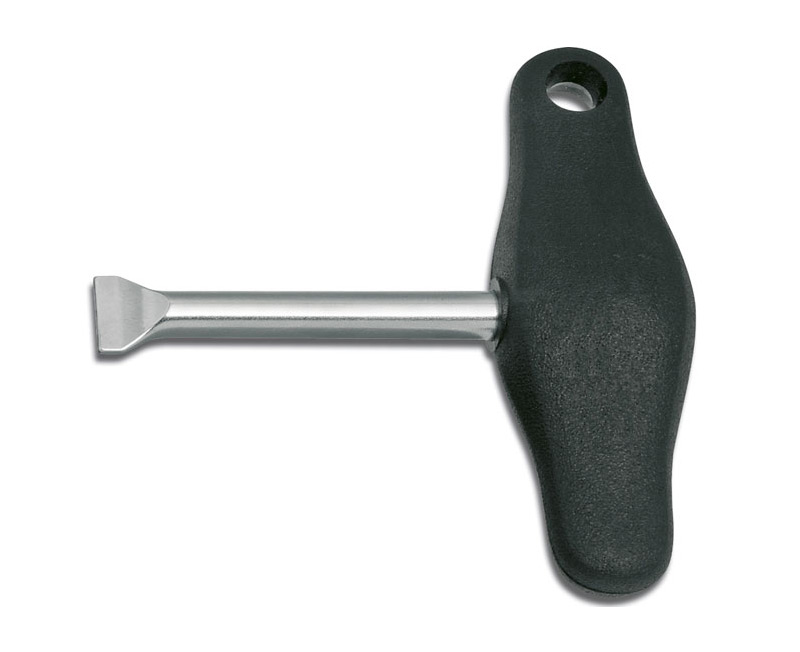
A fully charged battery can be stored till the open circuit voltage is 12,50V.
Depending on the temperature batteries can be stored up to 12 months without recharging.
The colder the storage temperature the lower the self discharging rate.
In order to be rather safe than sorry, it is advisable to check the off-load voltage of the battery after roughly three months. If this is < 12.50V, the battery should be recharged, while with < 12.60V another check after about a month is to be recommended.
When recharging outdoors, care should be taken that the battery temperature must rise to over 0°C in order that it will accept a charge.
If recharging is required, the battery can be removed and left to “thaw” in a room with >0°C. Alternatively, the charger can be connected to the battery for several days, as the charge energy is employed initially to heat up the battery.
There is no need for concern, as a fully charged lead-acid battery only freezes at approx. minus 70°C. However, a discharged battery (off-load voltage = 12.0V) freezes at just a few degrees below zero.
A few tips to note:
- Prior to recharging top up missing electrolyte with distilled or demineralized water to the maximum level.
- Before winter decommissioning, recharge the battery (separately) until the charger gauge shows that it is fully charged.
- Ensure that surfaces of the battery are dry and remain so.
- If the battery is removed from the vehicle, it should be stored in a dry place that is as cool as possible (fully charged).
- When storing the battery, provide it with short circuit protection.
- Fully charge the battery prior to installation in the vehicle and contact with its electrical system.
- Last, and most importantly, always use protective eyewear when handling lead-acid batteries.
Suitable chargers are available for automatic charge retention (all Banner Accucharger devices). Such chargers can remain connected to the battery throughout the winter without causing it any damage

Only different designations from different suppliers are used. For example, Mercedes notes VRLA on the top label of AGM start/stop car batteries.
VRLA car batteries can be replaced by the Banner Running Bull AGM. In identical box and in the same performance class.
AGM = Absorbent Glass Mat, the acid is absorbed in the glass fleece and thus bound.
VRLA = Valve Regulated Lead Acid, a valve-regulated lead/acid battery with AGM technology.
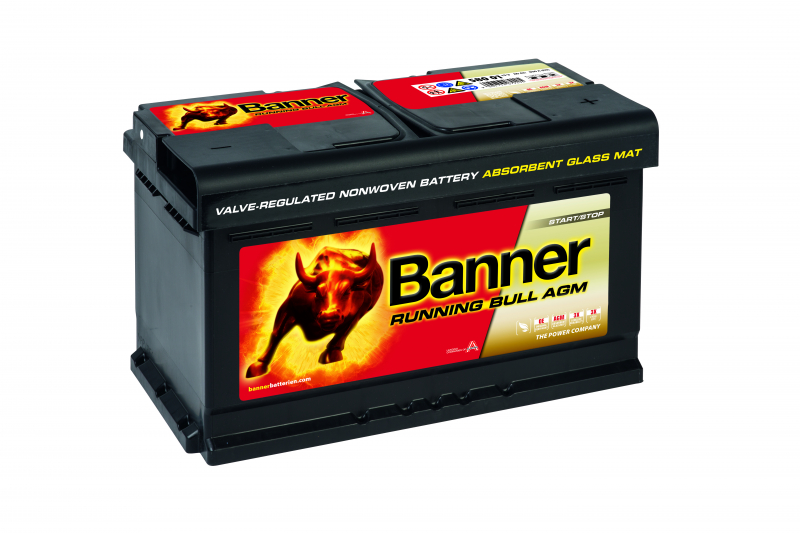
There are often different names used on the market for start/stop technology in the battery sector:
AFB = Advanced Flooded Battery
ECM = Enhanced Cyclic Mat
EFB = Enhanced Flooded Battery
AFB and ECM car batteries can be replaced by the Banner Running Bull EFB. In identical housing and identical performance class.
The "carbon loaded" technology enables better battery chargeability by incorporating carbon additives in the negative active mass. These carbon particles ensure increased conductivity of the active mass and increased current absorption capacity of the battery.
The result is a significant reduction in loading time!
Furthermore, the use of carbon additives reduces the gassing voltage, thus avoiding potential acid stratification.
It is not without reason that carbon is mentioned in the same breath as the most modern high-tech applications. Due to its low weight and at the same time enormous strength it is used in various areas - from motor sports, over aerospace up to offshore wind power plants... and now also in banner batteries!
Lead-acid batteries benefit from both the exceptionally good conductivity and the thermal properties of this high-tech material. Special carbon additives improve the chargeability and cycle stability of lead-acid batteries and show their full strength, especially in EFB batteries for vehicles with start/stop function or high energy consumption.
The use of carbon is further proof of the innovative power and continuous development work of banners, which is appreciated by renowned car manufacturers around the globe.
What is carbon?
Carbon is a chemical element found in nature in pure form (diamond, graphite) or in compounds such as carbonates, carbon dioxide, crude oil, natural gas and coal. Carbon is able to form complex molecules and forms the basis of all life on earth.

Yes, essential.
A conventional starter battery is, as the name suggests, basically designed to provide a high short energy boost to start the vehicle.
As soon as the engine is running, the vehicle's charging system ensures that the energy taken from the battery is recharged and supplies all other electrical loads.
When compared to running, the starter battery of the Sprinter and the long-term discharge battery would be a marathon runner.
A long-term discharge battery in the hobby/leisure time range is required in order to supply a considerably lower current for the on-board power supply and a large number of electrical/electronic consumers over a longer period of time; it is also discharged and recharged several times.
This means that the technology and components differ significantly from those of a starter battery, so that the use of a starter battery in a cyclic application can lead to premature battery wear or even total battery failure in the first months of operation.
Banner Tip: For a long service life of an on-board battery.
An on-board battery should be discharged to a maximum of 50% charge. In principle, the lower the discharge, the shorter the expected service life. Please ensure immediate and sufficient recharging after each discharge.


